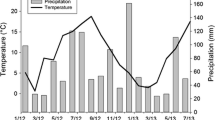Abstract
The transpiration of an isolated Scots pine (P. sylvestris), determined by weighing, was related to stomatal resistance and environmental factors. The tree had been sheared to 1.5 m diameter at the base and 1.8 m high. The transpiration (2.97 MJ for 12h) was rather constant throughout the day and similar in shape to direct beam radiation incident upon the side of a cone. Transpiration rates calculated with the gradient equation duplicated measured values when vapor density gradients (obtained from measured needle temperature), measured stomatal resistance, and characteristic width of 3 mm in aerodynamic resistance were used in the calculations. Net radiation (Q*) for the tree was calculated by replacing the direct beam component of measured net radiation with the direct beam component incident upon a cone. The sensible heat flux, calculated with needle temperatures, was large (50.8 MJ) and nearly equal to Q* (53.85). The resulting Bowen ratio was 17. Transpiration calculated with a modified Penman-Monteith type equation simulated measured values.
Similar content being viewed by others
References
CAMPBELL, G. S. (1977): An Introduction to Environmental Biophysics. Springer-Verlag, New York, pp. 159.
CHARLES-EDWARDS, D. A. and THORNLEY, J. H. M. (1973): Light interception by an isolated plant. Ann. Bot., 37: 919–928.
FRITSCHEN, L., COX, L. and KINERSON, R. (1973): A 28-meter Douglas-fir in a weighing lysimeter. Forest Sci., 4: 256–261.
FRY, K. E. (1965): A study of transpiration and photosynthesis in relation to the stomatal resistance and internal water potential in Douglas-fir. Ph. D. Dissertation. University of Washington, Seattle.
LANDSBERG, J. J. and THOM, A. S. (1971): Aerodynamic properties of a plant of complex structure. Quart. J. roy. Meteor. Soc., 97: 565–570.
MONTEITH, J. L. (1973): Principles of Environmental Physics. Edward Arnold, London, pp. 241.
NOBEL, P. S. (1974): Boundary layers of air adjacent to cylinders. Plant Physiol., 54: 177–181.
THORPE, M. R. (1978): Net radiation and transpiration of apple trees in rows. Agr. Meteor., 19: 41–57.
TURNER, N. C. and PARLANGE, J. Y. (1970): Analysis of operation and calibration of a ventilated diffusion porometer. Plant Physiol., 46: 175–177.
Author information
Authors and Affiliations
Rights and permissions
About this article
Cite this article
Fritschen, L.J., Walker, R.B. & Hsia, J. Energy balance of an isolated scots pine. Int J Biometeorol 24, 293–300 (1980). https://doi.org/10.1007/BF02250571
Issue Date:
DOI: https://doi.org/10.1007/BF02250571




